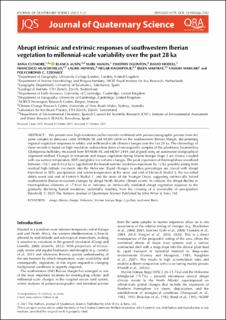| dc.contributor.author | Cutmore, Anna | |
| dc.contributor.author | Ausín, Blanca | |
| dc.contributor.author | Maslin, Mark | |
| dc.contributor.author | Eglinton, Timothy | |
| dc.contributor.author | Hodell, David | |
| dc.contributor.author | Muschitiello, Francesco | |
| dc.contributor.author | Menviel, Laurie | |
| dc.contributor.author | Haghipour, Negar | |
| dc.contributor.author | Martrat, Belen | |
| dc.contributor.author | Margari, Vasiliki | |
| dc.contributor.author | Tzedakis, Polychronis C. | |
| dc.date.accessioned | 2022-03-24T09:30:03Z | |
| dc.date.available | 2022-03-24T09:30:03Z | |
| dc.date.created | 2021-12-02T16:44:39Z | |
| dc.date.issued | 2021 | |
| dc.identifier.citation | Journal of Quaternary Science. 2021, . | en_US |
| dc.identifier.issn | 0267-8179 | |
| dc.identifier.uri | https://hdl.handle.net/11250/2987253 | |
| dc.description.abstract | We present new high-resolution pollen records combined with palaeoceanographic proxies from the same samples in deep-sea cores SHAK06-5K and MD01-2444 on the southwestern Iberian Margin, documenting regional vegetation responses to orbital and millennial-scale climate changes over the last 28 ka. The chronology of these records is based on high-resolution radiocarbon dates of monospecific samples of the planktonic foraminifera Globigerina bulloides, measured from SHAK06-5K and MD01-2444 and aligned using an automated stratigraphical alignment method. Changes in temperate and steppe vegetation during Marine Isotope Stage 2 are closely coupled with sea surface temperature (SST) and global ice-volume changes. The peak expansion of thermophilous woodland between ~10.1 and 8.4 cal ka bp lags behind the boreal summer insolation maximum by ~2 ka, possibly arising from residual high-latitude ice-sheets into the Holocene. Rapid changes in pollen percentages are coeval with abrupt transitions in SSTs, precipitation and winter temperature at the onset and end of Heinrich Stadial 2, the ice-rafted debris event and end of Heinrich Stadial 1, and the onset of the Younger Dryas, suggesting extrinsically forced southwestern Iberian ecosystem changes by abrupt North Atlantic climate events. In contrast, the abrupt decline in thermophilous elements at ~7.8 cal ka bp indicates an intrinsically mediated abrupt vegetation response to the gradually declining boreal insolation, potentially resulting from the crossing of a seasonality of precipitation threshold. | en_US |
| dc.language.iso | eng | en_US |
| dc.rights | Navngivelse 4.0 Internasjonal | * |
| dc.rights.uri | http://creativecommons.org/licenses/by/4.0/deed.no | * |
| dc.title | Abrupt intrinsic and extrinsic responses of southwestern Iberian vegetation to millennial-scale variability over the past 28 ka | en_US |
| dc.type | Peer reviewed | en_US |
| dc.type | Journal article | en_US |
| dc.rights.holder | © The Authors, 2021 | en_US |
| dc.description.version | publishedVersion | en_US |
| cristin.ispublished | true | |
| cristin.fulltext | original | |
| cristin.qualitycode | 1 | |
| dc.identifier.doi | 10.1002/jqs.3392 | |
| dc.identifier.cristin | 1963769 | |
| dc.source.journal | Journal of Quaternary Science | en_US |
| dc.source.pagenumber | 0 | en_US |

